

Calliandra is a shrubby plant bearing extremely ornamental foliage and flowers.
Calliandra key facts
Name – Calliandra
Family – Fabaceae
Type – shrub
Height – 6 to 13 feet (2 to 4 meters)
Exposure – full sun, part sun
Soil – well-drained
Foliage – deciduous or evergreen, depending on the climate
Flowering – April to August
Native to tropical climates, this plant needs sun and moisture to develop well.
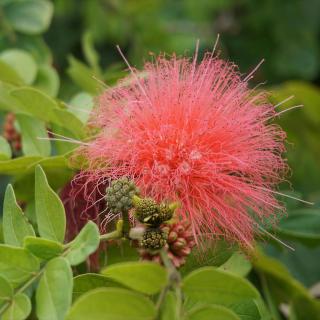
Calliandra presents high needs in terms of moisture since it comes from tropical climates. To compensate the dryness of the air, you can rest the pot on a bed of gravel or clay pebbles that are doused with water: evaporation will rise and weave through the leaves.
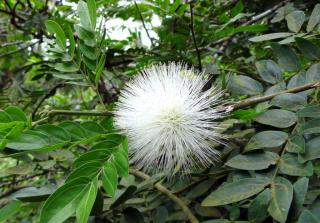
Watering is required frequently in summer, especially if the weather is warm.
If set indoors behind a window, avoid direct impact on the plant of the sun’s rays during the warmest hours of the day, mist water around the leaves if need be, with soft water.
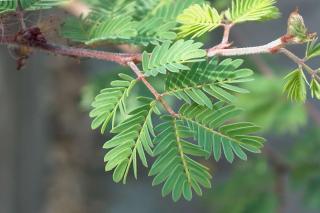
Avoid heat sources such as radiators.
Calliandra propagation comes in handy, since these shrubs don’t have a very long lifespan. Ten-fifteen years is considered honorable. You can multiply Calliandra through seed sprouting and cuttings to replace dying specimens.
Calliandra seeds form in pods that look like snow peas. Wait for the pod to have matured on the plant to the point that it pops open.
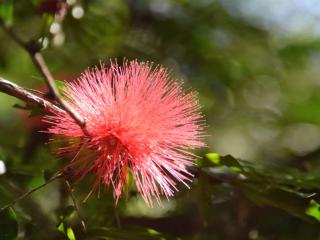 It helps to wrap the pods in a pouch or cloth to catch the seeds, but if you’ve got a large number of plants it usually isn’t a problem because they fruit prolifically.
It helps to wrap the pods in a pouch or cloth to catch the seeds, but if you’ve got a large number of plants it usually isn’t a problem because they fruit prolifically.Always prefer seeds from the healthiest plant and try to select a parent that grows nearby. Indeed, seeds from thriving local plants will be best suited to growing in similar environments within a same garden or neighborhood.
Cuttings is the other easy way to propagate your Calliandra.
Cuttings start rooting within about two weeks and are ready for transplant within a month and a half. Before planting, reduce risk of transplant shock by setting the pot in place for a week before digging and planting.
C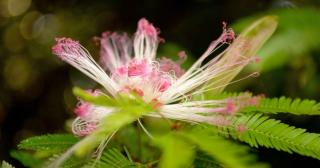
An exception to this is Calliandra eriophylla, commonly called the Fairy duster. It copes well with dry air, but it still needs watering at least every 5-8 days.
Pests are the usual culprits:
This elegant shrub native to Brazil bears interesting and unique flowers over the summer.
Since it is well suited to heat, it grows in pots well, even in the open sun.
When grown in a pot, you can bring it indoors over the winter in a cool spot where frost doesn’t creep in.
Read also about Calliandra:
To boost the blooming, you can add organic fertilizer once or twice a month as soon as the first flowers appear.
A large portion of my 11 year old Calliandra hedge against the interior of the South wall in Palm Springs CA is doing poorly with dead branches and loss of leaves, the portion on the inside of the East wall is doing great. Any suggestions what problems may be occurring and any solutions?
Hi David! Thanks for your patience. Not so easy to determine exactly what might be going on, but here are a few ideas.
First of all, 11 years is already a nice age for such shrubs, especially since those don’t get optimal sun. It’s a shrub that propagates readily and it doesn’t have a very long life cycle.
Also, the fact that the swimming pool is so close might have weakened the plant in the long run (chlorine spilling over).
Is the soil often waterlogged or does it drain well? There’s a slight chance of some type of root rot or fungus eating away at the plant, but since neighboring plants are doing ok I’m not convinced this is the case.
Try working on these steps in the following order:
– get a few cuttings started from stems that are on the healthiest plants. I rewrote the article to share how to get those started.
– you can also sprout seedlings, again from the healthiest of the South-wall plants (their seeds will be best suited to that particular micro-environment).
– to deal with fungus, try preparing fermented tea from either stinging nettle or horsetail. Spray on the whole plant and on the ground around the root along the wall once a week for a fortnight (3 times).
– to reinvigorate the plant, prune dead or dying branches off. Dip your shears in alcohol (cheap vodka or methylated spirits) between cuts. Two options here: 1) light pruning where only dead and dying branches are cut, and 2) deep pruning retaining only the three healthiest stems from ground level, and cutting each remaining stem back by two-thirds.
– if replacing the plants, amend the soil to increase drainage, this would help pool chemicals wash out of the way. Not much else to be done about the pool water issue (if relevant), I’m not sure spill water can be channeled away very easily without going into a dug-out drainage or the such.
So to sum it up, you’ll be enriching soil, neutralizing fungus, focusing growth by pruning and lastly getting the next generation ready if all this fails!
Hope this helps!